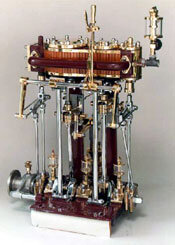York Double Expansion Marine Engine Castings
Cylinder dimensions, 3” + 5-1/4” x 3-3/4” (Spool valve HP, Slide valve LP)
Power: Consider for hulls <30 feet
Less complicated than the triple with half the parts, this engine design is faithful to steam age design principles. Compared to high RPM, short connecting rod British engines, the York Compound is taller, with long rods and less angularity, enabling higher torque at lower RPM.
Image 1 shows the engine with nickel plated steel parts and gold plated bronze parts; a simple and relatively cheap investment to reduce corrosion, especially in saltwater. Image 2 shows the castings packaged for shipping; Image 3 shows the cored HP piston valve and HP and LP cylinder bores; Image 4 shows a casting kit after the machine shop, black-primed and ready for the artificer to apply mahogany and brass lagging, and light-tone paint that will better show oil from a hot bearing. Image 5 shows the engine powering Eric J. at first-launch sea trials, with steam from a wood fired 2-1/2 sf grate under an Elliott Bay 40 square foot ASME Code vertical fire tube boiler, natural draft, in an Elliott Bay 23-foot fantail launch with a 20” diameter x 30” pitch propeller; total weight <2500 lbs.
York’s report of engine performance in a larger hull offers colorful perspective:
Dear Pat:
Per your request, I am writing this letter relating to the performance of my boat that was powered by one of my 3 & 5-1/4 x 3-3/4 compound steam engines.
HULL: 30” LOA, beam 7’6” max, 6’6” wL single chine all steel construction. Bare hull weight +/- 2,700 #. Total weight with steam plant about 8-9,000#. Weight on trailer (trailer included) a bit over 11,000#.
PLANT: Wood or oil burning boiler, 50 s.f. Roberts type with forced draft fan.
Working pressure 175#, cruise pressure, +/- 150 PSI 550 deg. F temp. Propeller was 24” x 28” P, ran max 430 RPM.
This gave me an HONEST 7 KNOT SPEED. When the plant was replaced by the 11 HP Hicks gas engine, we had got take off 3” pitch to get the proper 550 RPM Hicks called for and picked up about 1/2 - 3/4 knot speed, I suppose due to diminished weight, the power seeming to be about equal.
The bottom line—there were only a couple of boats in our large group that could out run me. I think this was the result of a number of factors: easy running hull, good free steaming boiler (forced draft and big grate) and superheating, and last but certainly not least of all, an engine capable of high running speed with superior steam distribution due to the “long legged” construction. As any engineering reader will discover, the shorter the connecting rod, the poorer will be the valve events and obviously the longer the rod, the better. This is because the connecting rod distorts the position of the piston in relative its angular position of the crankshaft. I assume that this also holds with the position of the valves in their travel. Bottom line here is, the “taller” the engine, the better. Anyone who would deny the engineering is a fool at best and dishonest at worst.
Best Wishes.





